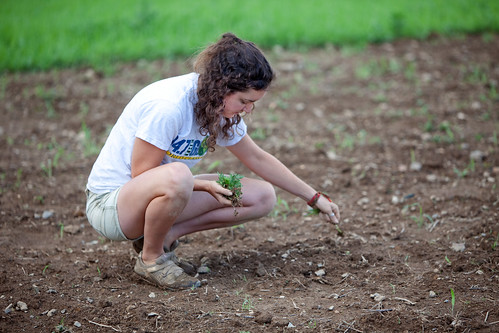Can someone tell me about organic gardening compost benefits?

Image by Lafayette College
Jennifer Bell ’11, is in charge of Lafayette’s organic garden.
Question by Gardening Guy: Can someone tell me about organic gardening compost benefits?
Everyone is talking about it, but why?
Add your own answer in the comments!

There are several benefits to using compost in your organic garden.
For one thing, the decomposing vegetable matter provides plant nutrients — the very sorts of nutrients that become depleted in the soil when you harvest your crops!
Another benefit is mulching — adding compost on the surface of the ground around the base of your garden plants. That helps shade the ground so the moisture doesn’t evaporate so quickly, and also reduces the likelihood of erosion.
In addition, incorporating the humus of compost into your soil helps it hold water more effectively, helps keep the soil friable, and aids both drainage and aeration. It encourages the activity of earthworms, too, which provide natural fertilizer in the form of their “castings.”
Feral
November 27, 2011 at 9:31 pm
If you’re asking about how organic gardening benefits you, first and foremost is that you are doing a mental and physical exercise at the very start of your activity. It will cost you less overhead expense. It’s also entertaining and rewarding. Healthy and worry free for personal consumption. And if you are planning to market it, it will be more attractive to the consumer/buyer because it’s a chemical-free produce. These are the only few answers to your question. I suggest you do some research on it.
ramby
November 27, 2011 at 10:30 pm
the greatest benefit to composted soil is ease of tilling . without organic matter some of those clays hard pan to the point of near impossible to plow and if you do succeed in plowing it you get hard rock-like chunks that never go away and the whole thing just packs right back again. compost blends with the clays keeping it from packing ,in a short time plowing is a dream. also water retention,bacteria action,access to worms,and soil that allows root penetration.
but remember ,compost is NOT soil ,it is an addition to soil,just as the clay can’t stand alone ,neither can be said for compost,they compliment each other,so not too much of either,and just till in well rotted compost,if too new it will rob the soil of nitrogen in the break down process,and some type fertilizer should be used ,a manure or 10-10-10- ,but sparingly ,not too much.
tholeeder
November 27, 2011 at 11:05 pm
i have gardened in compost only for 20 years. no dirt. every year i keep adding more from the grass and leaves in my yard, plus whatever else i have to put in there. i have had better gardens than ever, and never have to buy fertilizer. it has always worked great and i never had any kind of problems.
Martha Z
November 27, 2011 at 11:58 pm
Hi,
As you see in the other answers already posted, compost does protect the surface of the soil and so aids in keeping the plant roots cool. It also amends the soil, adding in nutrients as the compost is worked into the soil. This is especially helpful in heavy clay conditions since compost not only will add great nutrients, but also will lighten this type of soil and that helps in several ways–it adds little air pockets to the soil (always nice for roots) and allows for water drainage which is essential to protect your plants against root rot and all sorts of fungi diseases and other harm below the surface. So compost is helpful in a variety of ways.
Here’s a bit more on composting if you’d like to think about trying it yourself:
1) there are two types of composting: Active (or hot) and Passive (or cold). The active type makes compost lots faster, but is more labor intensive than passive composting.
2) Both use both green (such as grass clippings) and brown (such as fall leaves) as main ingredients, though most anything other than diseased plant matter is potential food for compost piles.
3) Here’s a bit about Carbon/Nitrogen ratios (which are the bottom-line for composting):
Everything organic has a ratio of carbon to nitrogen (C:N) in its tissues, ranging from 500:1 for sawdust, to 15:1 for table scraps. A C:N ratio of 30:1 is ideal for the activity of these microbes. Fresh grass clippings, with a C:N ratio of 20:1, have too much nitrogen. Brown tree leaves have too little: 40:1.
The proper ratio of grass to leaves may vary but should not exceed 1 part grass for 1 part leaves. Layering can be useful in arriving at these proportions, but a complete mixing of ingredients is preferable for the process. Other materials can also be used, such as weeds and garden wastes.
Generally, brown materials, such as fallen leaves and sawdust, are high in carbon, while green materials such as grass clippings and weeds are high in nitrogen.
If you save your fall leaves in bags or piles, they will provide an excellent source of carbon to mix with your grass clippings the following spring and summer.
Though the C:N ratio of 30:1 is ideal for a fast, hot mixture, a higher C:N ratio (i.e. 50:1) will be adequate for a slower one.
That should give you an overview of the uses and types of composting. If you want more detailed info, you can look at a page on this website that gives you the advantages and disadvantages of each type, plus a lot more information about organic gardening (as well as container gardening): http://www.container-gardening-made-easy.com/Organic-Gardening-Tips.html
Hope this helps,
Virginia
Virginia
November 28, 2011 at 12:25 am
Go Here: http://www.gardensuccesstips.com/ More tips!
jonluigi
November 28, 2011 at 12:51 am